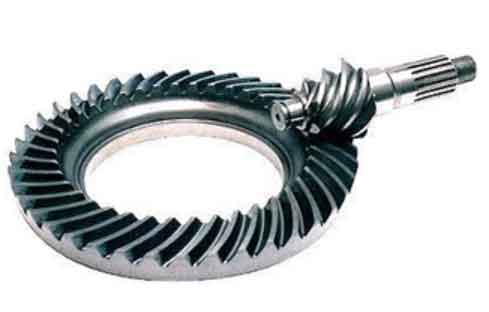Hypoid gears are a type of gears commonly used in various applications, particularly in the automotive industry. They are designed to transmit rotational motion between non-intersecting, non-parallel shafts. Hypoid gears are similar to bevel gears but have a different shape and contact pattern, which gives them distinct characteristics and advantages. In this discussion, we will examine the kinematics and operation principles of hypoid gears.

- Gear Geometry: Hypoid gears have a hyperbolic shape instead of the conical shape of bevel gears. This hyperbolic shape allows the axes of the gears to be offset, resulting in non-intersecting and non-parallel shafts. The offset between the gear axes creates a sliding motion between the gear teeth during operation.
- Tooth Contact Pattern: The sliding motion between the gear teeth in hypoid gears produces a unique tooth contact pattern. Unlike bevel gears that have a point contact, hypoid gears have a line contact along the tooth surfaces. This line contact distributes the load over a larger area, allowing hypoid gears to handle higher torque and transmit power more efficiently.
- Operation Principles: The operation of hypoid gears involves three important parameters: pitch cone distance, hypoid offset, and gear ratio.
- Pitch Cone Distance: The pitch cone distance refers to the distance between the apex of the gear teeth and the gear axis. It determines the size and shape of the pitch cones for the driving and driven gears.
- Hypoid Offset: The hypoid offset is the perpendicular distance between the gear axis and the common normal of the pitch cones. It creates the sliding motion between the gear teeth, resulting in the line contact pattern.
- Gear Ratio: The gear ratio is the ratio of the number of teeth on the driving gear to the number of teeth on the driven gear. It determines the speed and torque relationship between the input and output shafts.
- Kinematics: The kinematics of hypoid gears involve the rotational motion and sliding contact between the gear teeth. As the driving gear rotates, the sliding motion between the gear teeth causes the driven gear to rotate. The hypoid offset and gear ratio determine the speed and torque conversion between the gears.The motion of hypoid gears is complex due to the sliding contact, which results in axial and radial forces. These forces must be properly managed to ensure smooth operation and minimize wear.
- Applications: Hypoid gears are widely used in automotive applications, particularly in rear-wheel-drive vehicles. They are commonly found in differentials, where they transmit power from the engine to the wheels while allowing the wheels to rotate at different speeds during turns. Hypoid gears are also used in power tools, industrial machinery, and other applications that require efficient torque transmission between non-intersecting shafts.
Hypoid gears are a specialized type of gears used for transmitting rotational motion between non-intersecting, non-parallel shafts. They have a unique hyperbolic shape and sliding tooth contact pattern. Understanding the kinematics and operation principles of hypoid gears is essential for their proper design and application in various industries.
